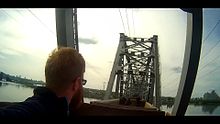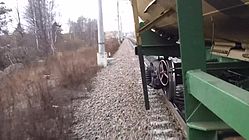Freighthopping
This article needs additional citations for verification. (January 2013) |

Freighthopping or trainhopping is the act of surreptitiously boarding and riding a freight railroad car, which is usually illegal. In the United States, this became a common means of transportation following the American Civil War as the railroads began pushing westward, especially among migrant workers who became known as "hobos." It continued to be widely used by those unable to afford other transportation, especially during times of widespread economic dislocation such as the Great Depression. For a variety of reasons the practice is less common today, although a community of freight-train riders still exists.[1]
Technique[]
This article possibly contains original research. (January 2013) |

Typically, riders will go to a rail yard where the trains switch out crew. They will either know from other riders of a spot to hide and wait, or they will find one themselves. Depending on the size and layout of the yard, riders may have to get on the train while it is moving; doing this is known as "catching on the fly."[2]
Safety concerns[]
Freight train cars are not designed for human riders; hopping on (or off) moving trains bears serious risk of dismemberment[3] or death. In March 1899, Welsh "tramp-poet" W. H. Davies lost the lower part of his right leg after jumping a train at Renfrew, Ontario. The incident is recounted in his 1908 book The Autobiography of a Super-Tramp. The 1944 Balvano train disaster involved (and was partially caused by) hundreds of freighthoppers. YouTube user hobestobe, aka Stobe the Hobo, was killed while freighthopping when he got snagged on a passing Amtrak train. Riding in a car itself can be dangerous too; freight cars often do not have floors, only narrow steel beams with the speeding tracks underneath. Riding on these beams is referred by hobos and hoppers to as "riding suicide," for their obvious danger. Being in a loaded car with shifting, heavy cargo can also be dangerous.
Riding the rods[]

In the 1900 to 1920 days of wood frame freight car construction, steel truss rods were used to support the underside of the car in order to provide it with the strength to carry heavy loads. There could be four or more of these truss rods under the car floor running the length of the car, and hobos would "Ride the Rods." Some would carry a board to place across the rods to lie on. Others would lie on just one rod and hold on tightly. Riding the rods was very dangerous. When a train moved at high speed, the cars could bounce and rock violently if the track was rough, and rock ballast might be tossed up which could strike a rider.
Modern day hopping[]
Hopping trains happens all over the world and varies from place to place. Some places are more critical and consider freight hopping a crime, and other places are more lenient.
United States[]
Union Pacific Railroad in the United States encourages people who witness transients on freight trains to report them to its dispatch center. According to a sheriff's deputy from Lincoln County, Nebraska train hoppers no longer write symbols on trees and buildings, but there is still a network of train hoppers that occurs mostly online.[4]
Mexico[]
It is estimated that yearly between 400,000 and 500,000 migrants, the majority of whom are from El Salvador, Guatemala, and Honduras, hop freight trains in the effort to reach the United States.[5][6]
Russia[]
Riding a freight train on the rooftop of a hopper car. Moscow Ring Railway, Russia
Riding a freight train on a gondola car and a forest flat car in Leningrad Oblast, Russia
Mauritania[]
In the Mauritania Railway, freighthoppers can ride with their cargo freely due to the lack of road between Zouérat and Nouadhibou[7]
See also[]
- Train surfing
- Hitchhiking
- Vagrancy (people)
- Boxcar Betty
- Emperor of the North Pole
- "King of the Road"
- William T. Vollmann
- Mike Brodie
References[]
- ^ "Black Butte Center for Railroad Culture". Bbcrc.org. Retrieved 2015-07-08.
- ^ Iverson, Wayne (2010). Hobo Sapien. Robert Reed Publishers. ISBN 1-934759-43-0.
- ^ "Boy critically injured trying to jump train in Northeast Philly". Newsworks.org. Associated Press. Retrieved 2017-07-22.
- ^ Johnson, Heather (August 28, 2018). "Ridin' the rails". The North Platte Telegraph.
Davis asks that people hitching a ride on trains be reported to the UPRR dispatch center at 888-877-7267.
- ^ Sorrentino, Joseph. "Train of the Unknowns". Commonweal. Retrieved 25 May 2013.
- ^ "Invisible Victims: Migrants on the Move in Mexico". Amnesty International Publishers. Retrieved 25 May 2013.
- ^ Mykolas, Juodele. "Freight Train Hopping In Mauritania: 4000 Kilometers In A Cargo Carriage With Local Shepherds And Their Sheep". Bored Panda. Retrieved 2020-12-21.
Further reading[]
- Uys, Errol Lincoln (2003). Riding the Rails: Teenagers on the Move During the Great Depression: Routledge. ISBN 0415945755 [1]
- "Riding the Rails", American Experience PBS series.
- Conover, Ted (2001). Rolling Nowhere: Riding the Rails with America’s Hoboes. Vintage. ISBN 0375727868 [2]
External links[]
| Wikiquote has quotations related to: Freight-hopping |
- Hobo Letters Letters from boxcar kids who rode the rails during the Great Depression
- Hitchhiking
- Passenger rail transport




